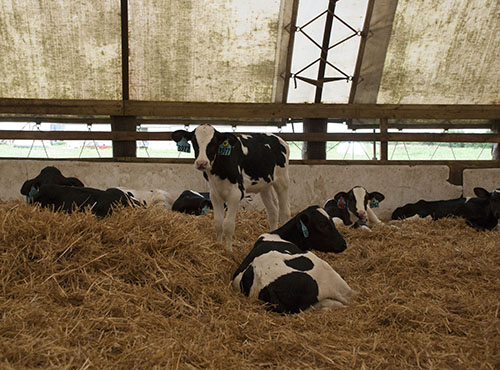
Automatic feeders and group housing are very trendy topics in calf raising today, and for good reason. The opportunity to feed more milk and provide social interaction appears to deliver great benefits to calves, in both the short and long term.
But when it comes to group size, there is a point where things can go south in a hurry. Many autofeeders are sized for 25 to 30 calves per station, but using these feeders at maximum capacity can introduce problems, explained Sandra Godden, University of Minnesota, at a PDPW Calf Care Connection workshop last week.
"The bigger the group, the more disease opportunity," she explained. "With 20 to 30 calves in a pen, you should expect more disease… it simply comes with the package."
Calf-to-calf contact, shared nipples, and a mixture of older and younger calves all add to the disease risk. These factors can be exacerbated by a lack of bedding or poor ventilation, she noted.
In one Swedish study, calves in larger groups (12 to 18 calves) had a 40 percent higher risk for respiratory disease than calves in smaller (6 to 9 calves) groups. The calves in the larger groups also had reduced rates of gain. In another Swedish study, calves in large groups (8 to 30 calves) had double the incidence of respiratory disease than calves raised in single pens or small groups (3 to 6 calves).
Another concern of bigger groups is competition at the feeder, leading to more stress, less time eating and more disturbances when at the feeder. Farms need to be sure that all calves have time to consume their daily allowance, Godden said.
Godden recommends that calves be fed 1.8 to 2.8 pounds of dry matter per day, approximately 8 to 10 liters (1.5 to 2.5 gallons), and they should receive 1.5 to 2.4 liters (about half a gallon) or more per meal.
Group housing also introduces the opportunity for cross suckling, but that shouldn't be a problem if calves are fed enough per meal and per day, Godden said. "We want calves to eat, lay down and sleep, and grow."
It appears group-raised calves do best when they are backgrounded in individual pens and not moved into group housing too soon. "Research is saying the older you can delay, the better the calf does," Godden noted. "Younger calves just don't learn as fast."
One study found that calves introduced at day 6 compared to day 14 were more restless and needed more guidance to the feeder. Another study also identified a 50 percent higher risk for respiratory disease in calves moved into groups at less than 12 days of age.
Based on what we've learned, ideal group size may be less than 10 calves, Godden explained. While that may not be a realistic for everyone, lowering the stocking density and providing 35 to 40 square feet per calf are good rules of thumb for those raising calves in groups, she said.

The author is an associate editor and covers animal health, dairy housing and equipment, and nutrient management. She grew up on a dairy farm near Plymouth, Wis., and previously served as a University of Wisconsin agricultural extension agent. She received a master's degree from North Carolina State University and a bachelor's from University of Wisconsin-Madison.








